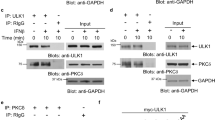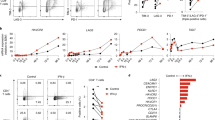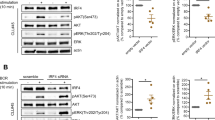Abstract
Interferon regulatory factors (IRF) 1 and 2 are DNA-binding proteins which control interferon (IFN) gene expression. IRF1 functions as an activator for IFN and IFN-inducible genes, whereas IRF2 represses the action of IRF1. Expression of the two regulatory genes is itself IFN-inducible. Because therapeutic responses of chronic myeloid leukaemia (CML) patients to IFN-α may be determined by intracellular levels of these two mutually antagonistic transcription factors, we have devised a competitive reverse-transcription polymerase chain reaction (RT-PCR) assay which provides an estimate of the ratio of IRF1 to IRF2 expression in a given cell population. Analysis of peripheral blood leucocytes from 25 normal individuals showed that the IRF1:IRF2 ratio varied between 1.13 and 2.30 (mean ± s.d. 1.49 ± 0.33). Similar values were obtained for normal bone marrow specimens, with no significant difference between CD34+ and CD34− cells. In contrast, the IRF1:IRF2 ratio in leucocytes from CML patients showed a much wider variation (0.53–5.11). Eleven out of 130 patients in chronic phase had ratios above the normal range, whereas none of the 33 blast crisis samples had a ratio >2.5. Analysis of diagnostic specimens in 59 CML patients treated subsequently with IFN-α showed a high IRF1:IRF2 ratio of 5.11 in one of two patients who became complete responders; all the 53 patients with minimal or no cytogenetic response had ratios below 2.5. In a separate series of 97 CML patients studied after IFN-α therapy a highly significant correlation was found between the IRF1:IRF2 ratio and both the cytogenetic and the molecular response (ie low concentration of BCR-ABL transcripts) to treatment: 53 out of 115 prospectively analysed samples of good cytogenetic responders had ratios above 2.0, as opposed to only 13 out of 91 samples from poor responders (P < 0.0001; χ2 test). We conclude that a high ratio of IRF1/IRF2 expression may be associated with good cytogenetic and molecular response to IFN- α in CML.
This is a preview of subscription content, access via your institution
Access options
Subscribe to this journal
Receive 12 print issues and online access
$259.00 per year
only $21.58 per issue
Buy this article
- Purchase on Springer Link
- Instant access to full article PDF
Prices may be subject to local taxes which are calculated during checkout
Similar content being viewed by others
Author information
Authors and Affiliations
Rights and permissions
About this article
Cite this article
Hochhaus, A., Yan, X., Willer, A. et al. Expression of interferon regulatory factor (IRF) genes and response to interferon-α in chronic myeloid leukaemia. Leukemia 11, 933–939 (1997). https://doi.org/10.1038/sj.leu.2400723
Received:
Accepted:
Issue Date:
DOI: https://doi.org/10.1038/sj.leu.2400723
Keywords
This article is cited by
-
The interferon-alpha revival in CML
Annals of Hematology (2015)
-
Biological therapy and the immune system in patients with chronic myeloid leukemia
International Journal of Hematology (2012)
-
Therapeutic Implications of Interferon Regulatory Factor (IRF)-1 and IRF-2 in Diffusely Infiltrating Astrocytomas (DIA): Response to Interferon (IFN)-β in Glioblastoma Cells and Prognostic Value for DIA
Journal of Neuro-Oncology (2005)
-
Drug-resistance gene expression and progression of astrocytic tumors
Brain Tumor Pathology (2001)
-
Regulation of CD26/DPPIV gene expression by interferons and retinoic acid in tumor B cells
Oncogene (2000)



